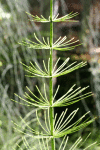A Transcriptomic Approach to Evolutionary Genetics of Giant Horsetail
- PMID: 26002870
- PMCID: PMC4498214
- DOI: 10.1105/tpc.15.00409
A Transcriptomic Approach to Evolutionary Genetics of Giant Horsetail
Figures
Comment on
-
Horsetails Are Ancient Polyploids: Evidence from Equisetum giganteum.Plant Cell. 2015 Jun;27(6):1567-78. doi: 10.1105/tpc.15.00157. Epub 2015 May 22. Plant Cell. 2015. PMID: 26002871 Free PMC article.
Similar articles
-
Horsetails Are Ancient Polyploids: Evidence from Equisetum giganteum.Plant Cell. 2015 Jun;27(6):1567-78. doi: 10.1105/tpc.15.00157. Epub 2015 May 22. Plant Cell. 2015. PMID: 26002871 Free PMC article.
-
Discovery of a multigene family of aquaporin silicon transporters in the primitive plant Equisetum arvense.Plant J. 2012 Oct;72(2):320-30. doi: 10.1111/j.1365-313X.2012.05082.x. Epub 2012 Aug 6. Plant J. 2012. PMID: 22712876
-
Effective half-lives of ¹³⁷Cs in giant butterbur and field horsetail, and the distribution differences of potassium and ¹³⁷Cs in aboveground tissue parts.J Environ Radioact. 2015 Mar;141:138-45. doi: 10.1016/j.jenvrad.2014.12.013. Epub 2015 Jan 9. J Environ Radioact. 2015. PMID: 25588954
-
Evolutionary genetics of genome merger and doubling in plants.Annu Rev Genet. 2008;42:443-61. doi: 10.1146/annurev.genet.42.110807.091524. Annu Rev Genet. 2008. PMID: 18983261 Review.
-
The Case of the Missing Ancient Fungal Polyploids.Am Nat. 2016 Dec;188(6):602-614. doi: 10.1086/688763. Epub 2016 Sep 26. Am Nat. 2016. PMID: 27860510 Review.
References
-
- Haufler C.H. (2014). Ever since Klekowski: testing a set of radical hypotheses revives the genetics of ferns and lycophytes. Am. J. Bot. 101: 2036–2042. - PubMed
-
- Soltis D.E., Visger C.J., Soltis P.S. (2014). The polyploidy revolution then…and now: Stebbins revisited. Am. J. Bot. 101: 1057–1078. - PubMed
-
- Van de Peer Y., Maere S., Meyer A. (2009). The evolutionary significance of ancient genome duplications. Nat. Rev. Genet. 10: 725–732. - PubMed
Publication types
MeSH terms
LinkOut - more resources
Full Text Sources
Other Literature Sources


